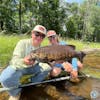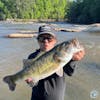S6, Ep 46: Ellis Ward's East Tennessee Euphoria: Dry Flies and Midge Magic
Host Marvin Cash reels in another exciting East Tennessee fishing report with local expert Ellis Ward on The Articulate Fly. As the seasons shift, Ellis shares his enthusiasm for the potential dry fly action, thanks to the upcoming weather changes bringing consistent rainfall and cooler temperatures to the region.
Ellis discusses the impact of recent water releases on the South Holston River, creating opportunities for anglers to explore waters that have been unfished for months. With the unlocking of predator lies and the dispersal of debris, the stage is set for a dynamic fishing experience. He highlights the promise of the sulphur hatch and offers sage advice on fly selection, including his trusty submerged midge patterns and topwater strategies.
Responding to a listener's question, Ellis delves into his favorite midge patterns for the season, emphasizing the effectiveness of a black zebra midge with a touch of shine. For surface action, he suggests patterns like the Griffith's Gnat and the CDC Puff Daddy, while also providing tips for managing tiny flies and delicate hook sets.
Whether you're a seasoned angler or new to the waters of East Tennessee, this episode is a treasure trove of insights and tips from Ellis Ward. Tune in to refine your approach, learn what's hatching and get ready to make the most of the upcoming conditions.
To learn more about Ellis, check out our interview!
All Things Social Media
Follow Ellis and Flyzotics on Instagram.
Follow Ellis on YouTube.
Follow us on Facebook, Instagram, Twitter and YouTube.
Support the Show
Subscribe to the Podcast
Subscribe to the podcast in the podcatcher of your choice.
Advertise on the Podcast
Is our community a good fit for your brand? Advertise with us.
In the Industry and Need Help Getting Unstuck?
Check out our consulting options!
Speaker:
Marvin: Hey folks, it's Marvin Cash, the host of the Articulate Fly,
Speaker:
Marvin: and we're back with another East Tennessee Fishing Report with Ellis Ward. How are you, Ellis?
Speaker:
Ellis: I am doing well, Marv. How are you?
Speaker:
Marvin: I'm getting there. I was looking at your weather, as I always do,
Speaker:
Marvin: and you know, you've got probably, looks like you've got a front coming through
Speaker:
Marvin: that's going to drop your temperatures, but the good news for you is you've
Speaker:
Marvin: got a little bit of rain for like the next four days. You ought to be going
Speaker:
Marvin: out of your mind on the draft life, right?
Speaker:
Ellis: Yeah, I'm pretty excited. It's been, you know, I think last we talked,
Speaker:
Ellis: it was just the tale of maybe the last two times of just that,
Speaker:
Ellis: you know, call it the shoulder season.
Speaker:
Ellis: I get a little cringy with that because you can always find something,
Speaker:
Ellis: but it truly was just a lot of wind, big sun,
Speaker:
Ellis: You know, followed by 80 degree days, followed by 40 degree days.
Speaker:
Ellis: So kind of mellowing out into some consistency here with even with the temperature
Speaker:
Ellis: dropping, you know, it's going down to low to mid 60s.
Speaker:
Ellis: I think tomorrow will be mid 70s, even with gray skies and rain coming through.
Speaker:
Ellis: So, yeah, on the drive-fly front,
Speaker:
Ellis: I'm guessing, I mean, it's pretty rare that these podcasts happen to fall on
Speaker:
Ellis: a day where I'm like, oh, man,
Speaker:
Ellis: the next foreseeable future looks really good compared to, let's just say, the last week.
Speaker:
Ellis: But that is the case today where just started getting some water moving on the
Speaker:
Ellis: South Holston and that's been the first time in years.
Speaker:
Ellis: Beyond the hour pushes, they'll do these pulse releases on the South Holston from the dam.
Speaker:
Ellis: And beyond that, there's been
Speaker:
Ellis: one or two hours intermittently where we're getting some all-day flows.
Speaker:
Ellis: And after it sort of clears up, that's been going for a day or two now.
Speaker:
Ellis: And after that, it sort of clears up because there's a lot of bank.
Speaker:
Ellis: There's just, there's a lot of structure.
Speaker:
Ellis: There's a lot of stuff that has not seen consistent high flows for months.
Speaker:
Ellis: I mean, since the fall.
Speaker:
Ellis: And so it's, you know, it's pushing some debris down, but that's,
Speaker:
Ellis: it kind of triggers a couple of things happening in the lake.
Speaker:
Ellis: And, you know, a lot of the, obviously, predator lies does open up when you get water.
Speaker:
Ellis: You can actually float the river. So it does a couple of different things.
Speaker:
Ellis: One, it obviously opens up the South Holston for fishing.
Speaker:
Ellis: And then for the Watauga and just for other areas in northeast Tennessee,
Speaker:
Ellis: it acts as sort of a siphon because it has not been fished and people have been,
Speaker:
Ellis: you know, guides primarily have been fishing the same sections of water on the
Speaker:
Ellis: Watauga day in and day out for a while now.
Speaker:
Ellis: And so a lot of the good stuff that on the Watauga has not seen much water.
Speaker:
Ellis: We've been getting a little bit here and there, maybe a week on,
Speaker:
Ellis: but generally pretty low water there too.
Speaker:
Ellis: But it's opening up with bigger water, and now we have two rivers.
Speaker:
Ellis: So there's just, there's a lot of river on both of the rivers that.
Speaker:
Ellis: It's almost new, and it's coinciding with the amount of the daylight that we have,
Speaker:
Ellis: which I continue to think is more influential than ambient temperatures.
Speaker:
Ellis: But getting getting some of the bigger yellow bugs and,
Speaker:
Ellis: kind of seeing the last of the caddis but those the big caddis those you know
Speaker:
Ellis: size 16 to 20 still hang around and then yeah man next couple days.
Speaker:
Ellis: Remains to be seen if if the first push of sulfurs are going to happen on an overcast day.
Speaker:
Ellis: It typically likes on your days. I was actually talking with a biologist about
Speaker:
Ellis: why that might be the case versus the blue wings.
Speaker:
Ellis: I think at the end of the day, some of the blue wings are pretty light and tan
Speaker:
Ellis: and some of the sulfurs are sort of darker and tan.
Speaker:
Ellis: So if you can get a dry fly or just fishing double dries that maybe one's an
Speaker:
Ellis: emerger and they're kind of in the 18-ish range and they're sort of yellowy tan,
Speaker:
Ellis: you'll probably be doing all right.
Speaker:
Marvin: Well, there you go. And, you know, we got a question for you while we're on
Speaker:
Marvin: the small bug topic from Tom. He wanted to get your thoughts on your favorite
Speaker:
Marvin: midge patterns for this time of year.
Speaker:
Ellis: Sure. Yeah, you mentioned Midge,
Speaker:
Ellis: and I immediately thought of Nymph,
Speaker:
Ellis: which I know folks don't necessarily – when I talk with people and, you know,
Speaker:
Ellis: be it other guides or folks that think I'm just a diehard streamer junkie or whatever,
Speaker:
Ellis: that tone elicits, yes, I love streamer fishing.
Speaker:
Ellis: Fishing yes i love dry fly fishing for you know my atsu class for a lot of beginning
Speaker:
Ellis: anglers for heck for people that were streamer fishing like there are spots where i like to stop and,
Speaker:
Ellis: and dunk some bugs in and um you
Speaker:
Ellis: know sit there and fishing indicators you know floating all day and and going
Speaker:
Ellis: with the current again fantastic way to catch fish just not necessarily my style
Speaker:
Ellis: so So I have been doing a lot of classes for ETSU.
Speaker:
Ellis: And man, this time of year just gets, there's just this life force emerging
Speaker:
Ellis: from under rocks, literally.
Speaker:
Ellis: So something about it gets me nymphing a lot more and gets me tying smaller bugs.
Speaker:
Ellis: So I'll say for the submerged.
Speaker:
Ellis: For the weighted, for the classic NIMH midge patterns, I can't get away from
Speaker:
Ellis: a black zebra midge with silver wire.
Speaker:
Ellis: And it's hard to – my buddy John was talking about A-B testing,
Speaker:
Ellis: some different patterns that he has, and a guy like that as thoughtful as he
Speaker:
Ellis: is, sure, you can do that.
Speaker:
Ellis: That but i think it's hard to be able to to
Speaker:
Ellis: compare and contrast the difference between
Speaker:
Ellis: let's say a black zebra midge
Speaker:
Ellis: on you know an 18 curve
Speaker:
Ellis: nymph hook with a two millimeter tungsten bead
Speaker:
Ellis: and a little bit of um you know
Speaker:
Ellis: densely wrapped black uv ice dub versus one with a 2.4 millimeter tungsten bead
Speaker:
Ellis: and no ice dub and you know like all that said with all the different variations in it,
Speaker:
Ellis: Something with a little bit of scraggly, dark, but also shiny collar.
Speaker:
Ellis: I see outfish two to one.
Speaker:
Ellis: And I tend to throw either a good piece of split shot or two smaller ones on.
Speaker:
Ellis: So I'm getting bugs down anyways. ways and avoiding some of the detail there
Speaker:
Ellis: it's it's something um small you know i also tie the zebra midges with a pretty
Speaker:
Ellis: significant taper and when you start talking about like a an 18,
Speaker:
Ellis: black zebra midge with a pronounced taper you start popping under rocks that thing looks like
Speaker:
Ellis: so much it looks like half of the little bugs in there and so there's standouts
Speaker:
Ellis: and i generally fish two nymphs and one of them this time of year is going to
Speaker:
Ellis: look a little more sulfur-y.
Speaker:
Ellis: Um but the yeah that that midge pattern even go down to a 22 but there's just
Speaker:
Ellis: this time of year there's so many bugs midges and and betas and sulfurs that
Speaker:
Ellis: are dark and there is segmentation.
Speaker:
Ellis: And that fly with the little scraggly whatever, it doesn't have to be UVI stub, some sort of dubbin.
Speaker:
Ellis: And that's certainly one of my go-tos. And then for the top water, it's the best water.
Speaker:
Ellis: This can be a tricky one just because you're oftentimes fishing in times where
Speaker:
Ellis: you can't see flies in the water.
Speaker:
Ellis: And when you do see the flies, they don't make hook that are even twice the
Speaker:
Ellis: size of what you're looking at, let alone the actual size. So, yeah.
Speaker:
Ellis: And I've tied down to a 26 and I'll fish that fly, but it's a little bit of
Speaker:
Ellis: a pain because you're fishing at that point to actually get a decent presentation with it.
Speaker:
Ellis: You're fishing on 6.5 or 7X, really 7X.
Speaker:
Ellis: And the diameter of that hook is the, you know, the wire gauge is so small that
Speaker:
Ellis: it is almost a zero hook set just because it's a fish that it's already in.
Speaker:
Ellis: And if you put any pressure onto 7X on a dry fly eat, especially if it's the
Speaker:
Ellis: first one of the day and you might have the yips, you're breaking that thing off immediately.
Speaker:
Ellis: So I tend to stop fishing dries around the 22.
Speaker:
Ellis: And at that point, you can go with the cluster. It is hard to get hackle that small.
Speaker:
Ellis: So, you know, fishing a Griffith's gnat is a great pattern.
Speaker:
Ellis: I've also seen people have different names for it, but the Puff Daddy,
Speaker:
Ellis: the Thread Body with a little bit of taper, not terribly pronounced,
Speaker:
Ellis: and then two or three wraps, Palmer CDC,
Speaker:
Ellis: which CDCs have shown great.
Speaker:
Ellis: Because it has these, all those little barbules have these really,
Speaker:
Ellis: really fine touch points, and it's random.
Speaker:
Ellis: It doesn't look like the hackle on an Atoms where it's these very finite touch
Speaker:
Ellis: points that are, for example, feet or legs from a bug.
Speaker:
Ellis: That CDC is just sort of splayed out, and it's all sort of touching in,
Speaker:
Ellis: you know, like thousands and thousands of different points.
Speaker:
Ellis: Um, so if you're not going super small, doing something that is more,
Speaker:
Ellis: you know, buggy or like a Griffith's gnat, um,
Speaker:
Ellis: or a messy CDC emerger, uh, like a puff daddy or are two good options.
Speaker:
Ellis: And then if you're tying or if you can find in the shop or you happen to know a guy,
Speaker:
Ellis: getting down into the 2022s and doing something like a CDC comparadon with a really sparse tail.
Speaker:
Ellis: And either hone in on your dry fly presentations because it's pretty easy to
Speaker:
Ellis: cast those things right through the film and the water or just drop it behind
Speaker:
Ellis: one of those 18s, drop it behind a Griffiths Nat, drop it behind a Puff Daddy,
Speaker:
Ellis: drop it behind some other.
Speaker:
Ellis: Honestly, Parachute Adams doesn't really seem like a buggy fly to me,
Speaker:
Ellis: but I like to not drink my own Kool-Aid, so I'll sort of pivot back to that every once in a while.
Speaker:
Ellis: Thing catches fish so put your your tiny bug um you know 12 to 18 inches behind
Speaker:
Ellis: that that bigger fly and it'll stop it from puncturing through the meniscus
Speaker:
Ellis: it'll sort of slow it down on its descent and also give you an indicator since
Speaker:
Ellis: you can't really see a size 22 yeah.
Speaker:
Marvin: And i would say maybe uh go with a decaf and only half of a strawberry pop tart
Speaker:
Marvin: and that'll help you on the early hook set.
Speaker:
Ellis: Yeah I mean you're also going to have me screaming about,
Speaker:
Ellis: I typically, I typically encourage hard hook sets.
Speaker:
Ellis: It's a good problem to have. I'll, I'll, I'll take a, I'll take an amped up hook set over not.
Speaker:
Marvin: Yeah, there you go. Well, you know, folks, we love questions at the articulate fly.
Speaker:
Marvin: You can email them to us or DM us on social media, whatever's easiest for you.
Speaker:
Marvin: And if we use your question, I will send you some articulate fly swag and you
Speaker:
Marvin: were going to enter, you know, drawing for some cool stuff from Ellis at the end of the season.
Speaker:
Marvin: And, you know, as we're getting ready to get into the thick of the sulfur hatch,
Speaker:
Marvin: Ellis, you want to let folks know where they can find you so they can book in fish with you?
Speaker:
Ellis: Yeah. Website is elliswardflies.com. Instagram, which is sort of most of a picture
Speaker:
Ellis: of what I'm doing on, we'll say, week-to-week basis.
Speaker:
Ellis: But that's at elliswardguides. and
Speaker:
Ellis: then if you want to give me a call and actually see what's what's going on on
Speaker:
Ellis: a day-to-day basis as opposed to websites sort of i'll do kind of a seasonal
Speaker:
Ellis: update um instagram is mostly what's,
Speaker:
Ellis: visually appealing um so if you want to talk about trips see what's going on
Speaker:
Ellis: here um book trip I best way to do that is myself running 513-543-0019.
Speaker:
Marvin: Well, there you go. Well, listen, folks, show it to yourself to get out there
Speaker:
Marvin: and catch a few. Tight lines, everybody. Tight lines, Ellis.
Speaker:
Ellis: Appreciate it, Marv.

Ellis Ward
Guide | Fly Tier
I am a full time, year round fishing guide in East Tennessee, based out of Johnson City. I also design and tie flies from midges to musky, process a thousand or so bucktails every season, teach at East Tennessee State University, and raise my daughter.










